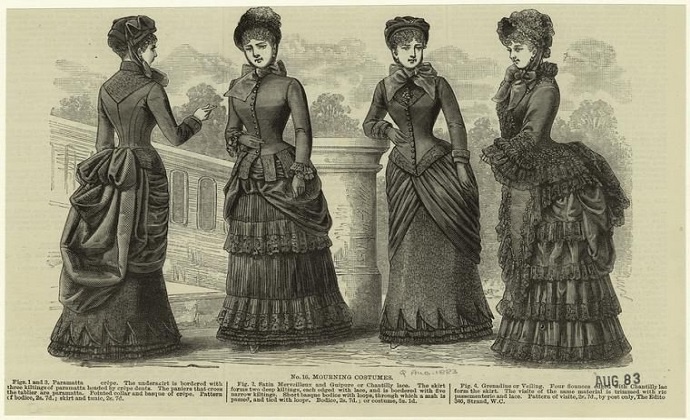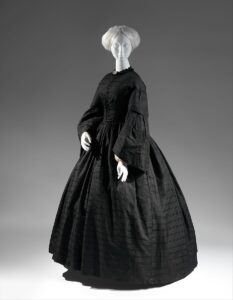Mid-Late Victorian Mourning Dress
When discussing mourning dress, people generally think of the Victorian era more than any other era in history. Though it remained part of a person’s wardrobe for many years prior, the Victorian era likely holds the most fame because Queen Victoria wore mourning dress for forty years after the loss of her husband, Prince Albert.
To the Victorians, black dress could symbolize mourning. But as with most things, there was much more to Victorian mourning than simply wearing black. With various stages of mourning and specific fabrics for each stage, clothing defined stages of grief without the wearer uttering a single word. However, mourning in the Victorian era balanced an interesting dynamic between strict rules and open interpretation. And yes, people had many varying opinions on the subject!
Because the Victorian era encompasses a large span of time (1837-1901), today’s blog post will focus on the late 1850s to late 1880s.
Length of Mourning
The length of mourning varied depending upon the relation to the deceased, personal choice, financial status, age of the mourner, and social expectations. The social expectations on mourning varied greatly. For example, Godey’s Magazine, Volume 54 (1857) mentions that Philadelphians remain the strictest of mourners, with women’s veils down and shutters closed much longer than New Yorkers and Bostonians.
Contemporary sources go back and forth on acceptable lengths of mourning to the point where many commenters reflected on the impossibility of establishing any rules.
Originally published in 1860 with many editions published in later years, Florence Hartley’s 1876 edition of The Ladies’ Book of Etiquette, and Manual of Politeness says it all:
“There is such a variety of opinion upon the subject of mourning, that it is extremely difficult to lay down any general rules upon the subject. Some wear very close black for a long period, for a distant relative; whilst others will wear dressy mourning for a short time in a case of death in the immediate family. There is no rule either for the depth of mourning, or the time it may be laid aside.”
A.B. Philputt reiterates an undeterminable length of mourning, but stresses that rules exist with mourning dress as a fashion style in American Etiquette and Rules of Politeness (1882):
“In the United States no prescribed periods for wearing mourning garments have been fixed upon. When grief is profound no rules are needed. But where persons wear mourning for style and not for feeling, there is a need of fixed rules.”
Interestingly, Helena Rowe’s article, “Family Fashions and Fancies: Mourning Costumes—English and French Styles,” featured in Good Housekeeping, Volume 9 (1889), makes a note of the inability to lay down rules while laying down a rule at the same time:
“The London code prevails in New York in all these matters. The time during which crape is worn varies with individual feeling and no rules can be laid down. It is not, however, considered in good taste for a widow adopting mourning to lay aside her crepe and enter society in less than a year.”
From Rowe’s statement above, we see an implied societal understanding that one year in crepe for a widow simply will not do. So, there must be some rules out there, correct? Even with all the disputes, there were rules to length of mourning. Philputt lays out one rule of thumb based on relation to the deceased:
- 2 years of mourning for a deceased husband
- 1 year of mourning for deceased parents
- 1 year of mourning for deceased children
- 6 months of mourning for deceased grandparents
- 6 months of mourning for deceased friends when the mourner received an inheritance
- 6 months of mourning for deceased siblings
- 3 months of mourning for deceased aunts and uncles
Philputt also makes a note that a woman should wear black dress upon invitation to funeral ceremonies, even if she is not specifically in mourning for the deceased.
But perhaps Godey’s Magazine says it best. In Godey’s Magazine, Volume 93 (1876), writers explain that though disputes in length of mourning arise from individuals following their own ideas to some extent, mourning dress itself does not change. In other words, people still went into mourning for a period of time and still collectively wore appropriate fabrics to reflect their grief. What remains, then, is a visual display of the emotional progression of grief through the progression (however long) of wearing black to lighter colors.

Stages of Mourning and the Fabrics to go with it
Stages of mourning include deep mourning (for widows only), first mourning, second mourning, third mourning, and half mourning. Not every stage was observed by everyone, and people did not always follow in rigid, sequential order. The following list of stages aim to illustrate the specific list of fabrics, colors, and trims (or lack thereof) deemed appropriate. It is not, however, a strict list of stages every Victorian followed.
Deep Mourning
Deep mourning had the strictest and most simple fashion choices. This stage typically existed for the widow mourning her husband for two years, with fabrics of the deepest black without any luster or trimmings. Rowe states that wearing deep mourning for any occasion beyond that of the widow was “in extremely bad taste.”
Eliza Bisbee Duffy defines fabrics suited for deep mourning in The Ladies’ and Gentlemen’s Etiquette: A Complete Manual of the Manners and Dress of American Society (1877):
- Serge (heavy wool)
- Bombazine (wool and silk)
- Alpaca fibre
- Delaine or de laine (fine combing wool)
- Merino (thinner/softer wool)
- Crape or crepe (silk) for collars, cuffs, bonnets, and veils
Duffy prohibits the wearing of jewelry and states that all pins or buckles must be black. Of course, she also prohibits any trimmings, such as bows, flounces, and ruffles. The widow also wears black gloves. The only other color permissible besides black is the white widow’s cap made of tarlatan (muslin).
Hartley provides the following fabrics for deep mourning in The Ladies’ Book of Etiquette, and Manual of Politeness (1876)
- Bombazine
- Parramatta Cloth (wool and silk or wool and cotton)
- Delaine
- Barege (sheer wool, silk, and/or cotton mix)
- Merino
The only trimming Hartley permits comes in the form of a deep fold in the dress, made either from the same material as the dress or of crape. Like Duffy, Hartley advises the use of a veil and bonnet in crape, as well as cuffs and collars in crape. Black boots and black gloves accessorize the widow’s deep mourning dress.
Godey’s Magazine Vol. 93, (1876) and Rowe’s article in Good Housekeeping (1889) prescribe Henrietta cloth, which is made of wool.
Rowe continues on to explain other requirements for deep mourning:
- Crape bonnet
- No jewelry
- Crape veil 3 yards in length with 2/3rds of the veil at the back and 1/3 over the face
- Veil thrown back after 6 months
- Crape collar and cuffs
First Mourning
First mourning comprises mourning for other relations not pertaining to the widow. In Godey’s Magazine, Volume 54 (1857) writers define the following characteristics to first mourning:
- Deep black colors of crape and tulle
- Black crape collars
- Trimmings of bows, ruches, and frills in black crape or tulle
- Black bonnet in crape or bombazine
Second Mourning
Second mourning begins to introduce a bit more elements. This stage also is considered the first stage for distant relatives, or those who have previously worn black.
Duffy lays out several new elements to second mourning:
- White collars and cuffs instead of black collars and cuffs
- Net or tulle veil instead of a crape veil
- Black jewelry
Hartley adds the following elements to second mourning:
- Straw bonnet with black ribbon or crape flowers
- Silk bonnet with black flowers
- Black silk
- White shawl
Third Mourning and Half-Mourning (Lesser Mourning)
Third mourning and half-mourning sometimes lump together into lesser mourning. Hartley combines the two stages together in a quick wrap up of mourning, explaining that dresses continue to change to lighter colors of lead, lavender, and white with a white bonnet, white shawl, and a lavender dress worn last before exiting mourning. Duffy makes similar conclusions in lesser mourning, too, with her advisements as follows:
- Light grey, white, or black
- Black lace bonnet with white or violet flowers
- Black and gold jewelry
Duffy goes on to explain that foulard, a silk or silk/cotton mix fabric, stands in as a suitable half mourning fabric.
Worn Grief and Social Reactions

American, silk; The Metropolitan Museum of Art, New York, Brooklyn Museum Costume Collection at The Metropolitan Museum of Art, Gift of the Brooklyn Museum, 2009; Gift of Mrs. F. W. Cameron, 1955 (2009.300.6884)
Though wearing mourning dress for long periods of time seems foreign to us today, it dominated Victorian society. Mourning dress also triggered a variety of positive and negative opinions. On one side, mourning dress brought acknowledgement of loss as a way to grieve.
According to Catherine Ann Edmonston of North Carolina, mourning dress kept the memory of her late father with her. In her 1861 diary entry, she wrote:
“Have been all this week in a sad task making up my mourning for my dear Papa & today for the first time put it on. The sight of this black dress brings the cause why I wear it more fully to my mind, if possible brings him more vividly before me.”
On the other hand, the rules and regulations of mourning dress elicited classism and brought hardship to those who could not afford to purchase entirely separate fabrics for mourning. Godey’s Magazine, Volume 54 (1857) elaborates on this detail:
“We quarrel with the fashion, but not the custom of mourning […] whose means would not allow the additional expense, into making it at a time when money could least be spared. The poorest, and those who are more to be pitied than the absolute poor, those who try to conceal straitened means, and keep up an appearance of comfort, were thus forced into expenditures that required the pinching and saving of months, and sometimes years, if met at all.”
In a push and pull of varying opinions, mourning dress in the Victorian era goes beyond simply wearing black. It triggered an entire response in the rules of fashion, bringing peace to some and striking a cord to others. Its rules brought order to an otherwise unstable time, and it also exploited pockets in costly expenses. Most of all, mourning dress served as a tangible reminder of what notoriously is hardest to express: loss of loved ones.
From History From The House